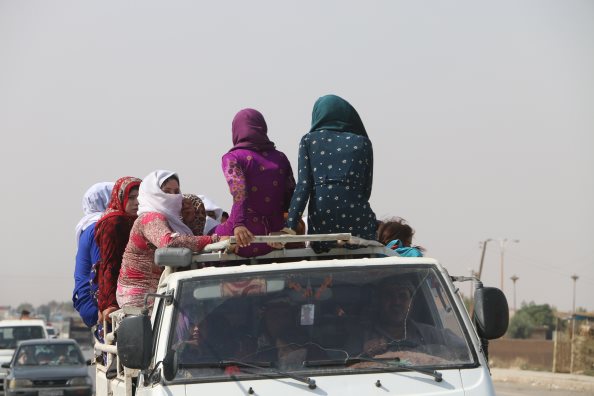WFP scaling up to reach more vulnerable people in the conflict-affected northeast of Syria
Damascus – The United Nations World Food Programme (WFP) says it has so far provided emergency food assistance to more than 300,000 people in Syria as a result of recent military operations in the northeast of the country. Those assisted include people displaced by hostilities and families providing shelter to the displaced. Many fled their homes with little or nothing, finding refuge in schools or with family and friends living further to the south.
Meanwhile, WFP is scaling up its regular food assistance to reach as many as 580,000 vulnerable people in Hasakeh and Raqqa governorates including many of those who recently were recently uprooted. Most of the displaced people fled Ras al-Ayn in Hasakeh and Tell Abyad in Raqqa.
The situation in northeast Syria is unpredictable. While tens of thousands have since returned to areas they abandoned after the hostilities earlier this month, more than 100,000 people are reported to be still away from their homes. In addition, as many as 12,000 Syrians have recently fled the north-east of the country, crossing into neighbouring Iraq where they have sought shelter in camps.
In northwest Syria, while levels of violence have decreased significantly, hostilities continue to result in more people forced to move. WFP has been responding through its cross-border operations via Turkey and is reaching food-insecure people with food assistance despite the challenges. Since late April, fighting has forced more than 400,000 people to abandon their homes, most of them seeking shelter in camps in north Idlib.
In southern Syria, WFP is concerned that conditions in Rukban on the border with Jordan have deteriorated in recent months. A number of displaced children living there are reported to have died of preventable causes. Humanitarian organisations have limited access and means to provide basic supplies and services to people living in squalid conditions in the makeshift camp.
Across Syria, WFP assists more than 4 million people every month. While increasing numbers are returning to their homes, many others remain displaced and in need of support. Despite recent improvements in security in most parts of Syria, the humanitarian situation remains dire.
Poverty affects more than two-thirds of the population in Syria. Unemployment is running at 50 percent and is as high as 80 percent among young people. It is vital that the humanitarian community maintain a lifeline of food assistance to vulnerable people, particularly those who have been displaced by conflict within and beyond Syria’s borders.
A recent food security assessment in 10 out of 14 governorates in Syria found an increase in food production this year across the country compared to last year, due to good levels of rainfall and improved overall security. While wheat production has almost doubled this year compared to last year, it has only reached 60 percent of pre-conflict levels.
# # #
The United Nations World Food Programme - saving lives in emergencies and changing lives for millions through sustainable development. WFP works in more than 80 countries around the world, feeding people caught in conflict and disasters, and laying the foundations for a better future.
Follow us on Twitter @wfp_syria, @wfp_mena, @wfp_media

